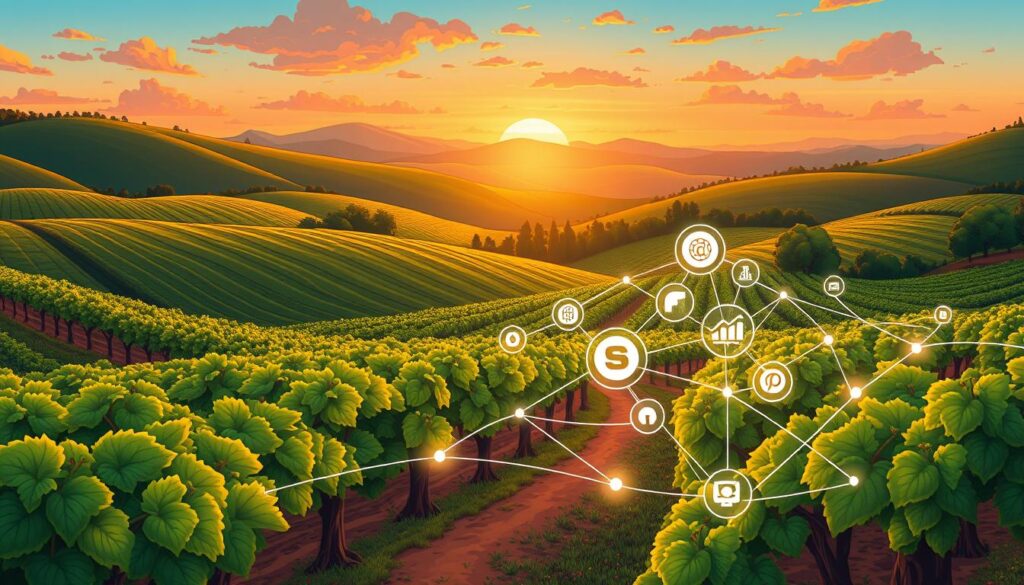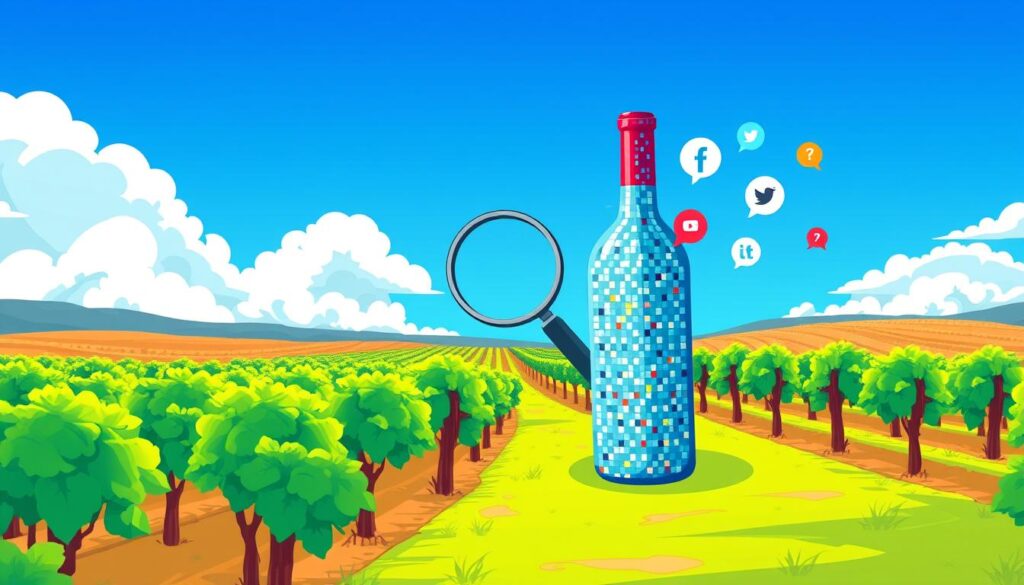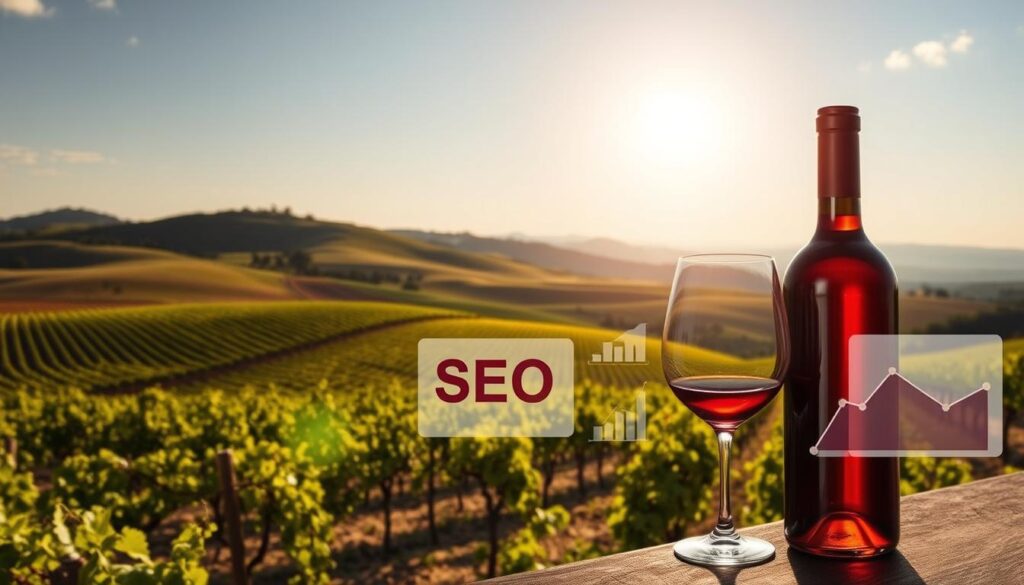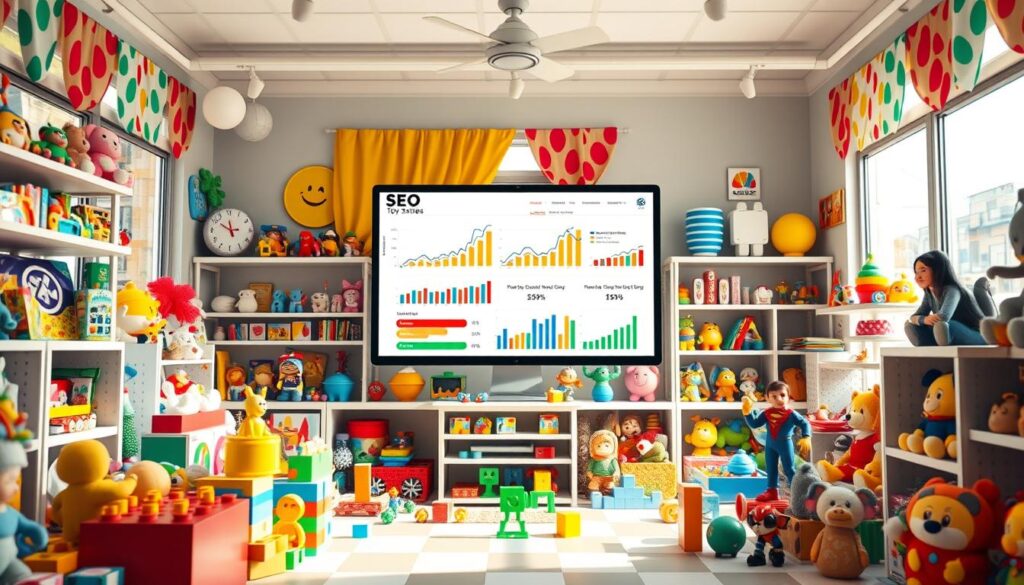What if the secret to boosting your winery’s sales is in your marketing? The wine industry is always changing. Wineries must not only make great wines but also share their stories with customers. Marketing is key to attracting people, building loyalty, and standing out.
As the wine market grows, using new marketing strategies is vital. Wineries usually spend 7-8% of their income on marketing. But for growth or new wine launches, this can rise to 10-20%. Using digital marketing, like social media ads and e-commerce, along with events and local partnerships, can help a winery grow.
Key Takeaways
- Allocate 7-8% of gross revenue to maintain visibility; increase to 10-20% for growth.
- Leverage a mix of digital and traditional marketing strategies to engage local and national markets.
- Hosting events and tours can generate excitement and foster unique experiences for customers.
- Implementing a customer loyalty program can encourage repeat business.
- Storytelling through content marketing helps establish wineries as industry leaders.
- Monitor online reviews as they can shape consumer perception significantly.
- Partnerships with influencers can amplify reach and brand credibility.
Understanding the Unique Challenges of Winery Marketing
Wine marketing faces special challenges that need unique solutions. Wineries must find ways to stand out in a crowded market. They also have to deal with legal rules that can limit how they promote their brand. Good winery branding is key to connecting with customers and getting noticed everywhere.
Distinguishing Your Brand in a Competitive Market
In the competitive world of wine, wineries must tell compelling stories about their products. Talking about how they make wine, the land it comes from, and the experiences of their customers can make a brand unique. Studies show that stories in marketing are 22 times more memorable than just facts.
This approach helps create emotional bonds with customers. It makes them more likely to remember and choose a brand.
Navigating Regulatory Restrictions
Each state has its own rules for alcohol marketing, which can be tricky for wineries. Following these laws is crucial for how they promote their products. Wineries must keep up with these rules to create effective marketing strategies that respect the law while building their brand.
Building a Local and National Reputation
Wineries need a strong reputation to grow beyond their local area. Partnering with local businesses, joining community events, and having a strong online presence can help build loyalty. Working with local artisans and artists can also expand their reach.
Hosting virtual events like tastings and tutorials is a creative way to engage with customers. It helps increase brand visibility across the country.
| Marketing Strategy | Potential Impact |
|---|---|
| Storytelling | Increases memorability and emotional connection |
| Social Media Advertising | Generates up to hundreds of thousands of impressions for as low as $500 |
| Influencer Collaborations | Supports new releases and promotional campaigns |
| Email Marketing | Key for direct-to-consumer sales effectiveness |
| Community Events | Builds local loyalty and enhances brand reputation |
For more insights on improving your marketing, check out detailed SEO basics for your winery’s online presence.
Effective Digital Marketing Strategies for Wineries
In the competitive wine market, wineries need to grab customers’ attention. Digital marketing is key for growth and visibility. With so many wine labels and winemakers, having a strong online presence is crucial.
Crafting a Captivating Website
A good website is like a virtual tasting room. It should have great images and easy-to-use navigation. Secure online shopping is important for turning visitors into buyers.
Writing about vineyard life in blog posts can help your site rank better. This boosts your digital marketing efforts.
Maximizing Social Media Engagement
Social media is vital for connecting with wine lovers. Instagram and Facebook are great for sharing beautiful photos and videos. They also let you show off live tastings and behind-the-scenes moments.
Smartphone users spend a lot of time online. This makes social media a big chance to engage with people. It’s especially important for brands to be active online, especially for young people.
The Role of Email Marketing
Email marketing is great for keeping in touch with customers. Newsletters with special offers and updates can keep people interested. This can lead to more sales.
Studies show that email marketing can bring in a lot of money. It’s a way to keep customers happy and share their experiences. This helps your business grow.

To improve your marketing, look at how other industries use digital marketing. Check out Revenue Boomers for ideas. By using smart strategies from different fields, wineries can stay ahead in the market.
SEO Best Practices for Wineries
Search engine optimization (SEO) is key for wineries to be seen online. Using good SEO tactics can draw more people, engage wine lovers, and boost sales. It’s important to use the right keywords on a winery’s website to rank higher in search engines.
Importance of Keywords in the Wine Industry
Choosing the right keywords is vital for wineries to reach potential buyers. Using terms like “wine club” or “local vineyards” can bring in more visitors. Industry insights show nearly 9,900 searches for wine clubs happen every month in the US. By using targeted keywords, wineries can build a strong online presence and stand out.
How Revenue Boomers Can Help Your SEO Efforts
Working with a professional SEO agency like Revenue Boomers can help wineries use effective SEO tactics. They can help with keyword research, getting backlinks, and improving content. Revenue Boomers have helped clients get over 24 million leads, showing their success in boosting online visibility. They also make sure websites are easy to use and load quickly, which is important for SEO.
Local SEO Strategies to Attract Visitors
Local SEO is crucial for wineries to attract visitors and wine tourists. Optimizing Google My Business listings and keeping NAP information consistent can improve visibility. Regular updates and using multimedia like videos can also engage visitors. These local SEO efforts help wineries stay top of mind for potential customers.

| Strategy | Description | Impact on SEO |
|---|---|---|
| Keyword Optimization | Incorporating relevant keywords throughout the website. | Increases organic traffic and improves search rankings. |
| Backlink Acquisition | Gaining links from reputable sites to enhance authority. | Acts as a vote of confidence for the winery’s site. |
| Content Quality | Providing high-quality, informative content. | Encourages visitor engagement and repeat traffic. |
| Regular Updates | Updating website content to keep it fresh and relevant. | Favors better rankings with search engines. |
| Mobile Optimization | Ensuring the website is responsive and user-friendly on mobile. | Improves user experience, impacting search rankings positively. |
Using these SEO best practices can greatly improve visibility and drive more traffic to winery websites. Wineries that keep improving their SEO will likely see better results than traditional ads.
Engaging Content that Sells Wine
Content marketing is key to a winery’s success. It helps build a strong bond with customers through stories, blog posts, and visuals. This not only boosts brand awareness but also keeps customers coming back.
Blogging About Wine and Vineyard Life
Writing about vineyard life and winemaking helps people appreciate wine more. Sharing tips on pairing wine with food or grape varieties can grab readers’ attention. Companies with blogs get 67% more leads each month than those without.
Having local chefs or sommeliers guest blog adds new insights. Staying up-to-date with wine trends keeps your audience interested and informed.
Creating Compelling Visual Content
Great visuals are essential for attracting new customers. Photos and videos on social media can reach more people. Tools like Desygner make it easy to create eye-catching content, even for those without design skills.
Posting valuable visuals regularly helps your winery’s voice be heard. It builds a loyal following over time.
Leveraging Customer Testimonials
Positive reviews from customers boost trust and credibility. User-generated content feels more real and relatable. Sharing local events or winery experiences strengthens loyalty and attracts new visitors.
Being open about winemaking processes shows your winery’s expertise. This can lead to more sales and conversions.
| Content Type | Benefits | Examples |
|---|---|---|
| Blog Posts | Increases leads, customer engagement, and SEO | Wine pairing tips, vineyard stories, industry trends |
| Visual Content | Captivates audience, builds brand image | Photos, videos, infographics |
| Customer Testimonials | Builds trust and credibility | Positive reviews, user stories, community engagement |
Measuring Success in Winery Marketing
Wineries need to check how well their marketing works to stay ahead. Looking at sales data helps them understand what customers like. This way, they can make better choices for their marketing.
By checking things like how many people buy and how much they spend over time, wineries can see if their marketing is working. They can then change their plans to do even better.
Analyzing Sales Data and Trends
Wineries should watch their sales closely. This helps them find out which products are making money and what customers want. They can then adjust what they sell and how they promote it.
Knowing how different ways of selling help their business grow is also key. This information helps them decide where to focus their marketing next.
Monitoring Online Engagement Metrics
In today’s world, it’s important to keep an eye on how people interact online. This includes website visits, social media likes, and email opens. By watching these numbers, wineries can see if their marketing is working right away.
Using tools to make this easier can give them even more useful information. They can learn from this guide to improve their online marketing.
Adjusting Strategies for Continuous Improvement
Wineries should always be ready to change their marketing plans based on what they learn. Being flexible shows they care about making their marketing work well. It also helps them focus on what’s really successful.
By keeping their marketing strong, wineries can build better relationships with customers. This leads to more people coming back. Always looking to improve is key to growing and succeeding in a fast-changing market.






